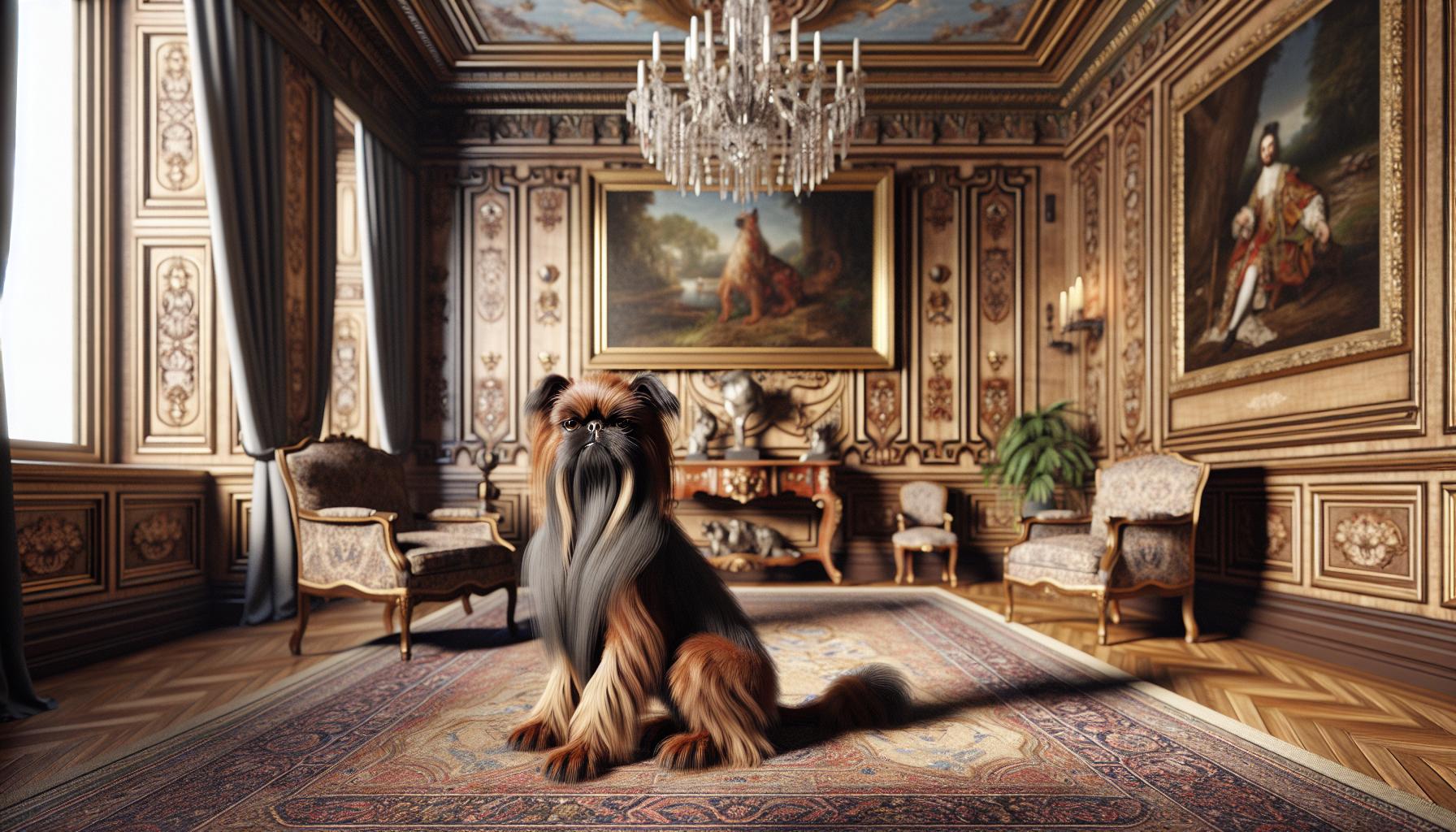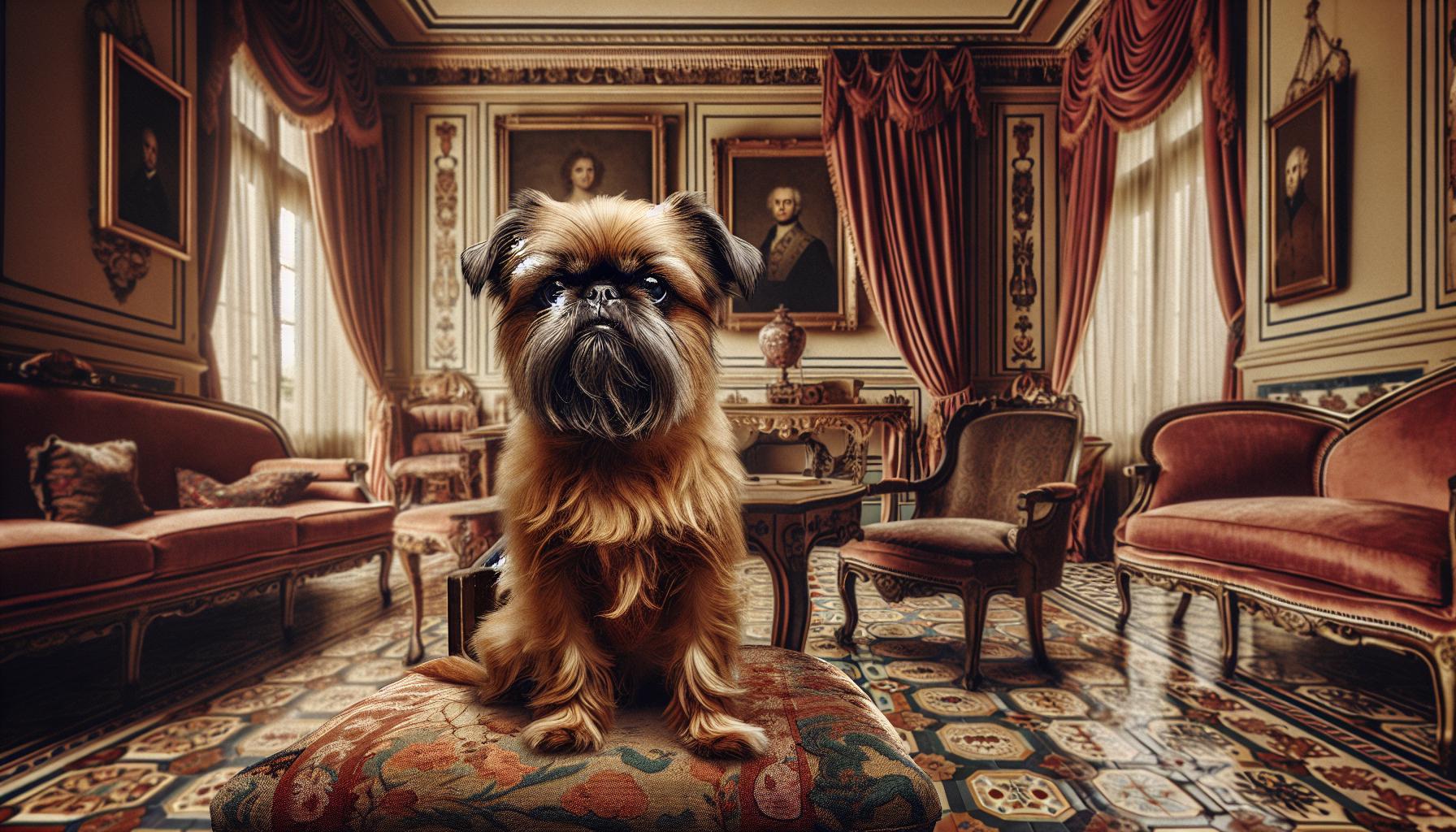Imagine stepping back into 19th-century Brussels, where the charming Brussels Griffon first captured hearts. Originating from Belgium, these pint-sized pups have a history as rich and fascinating as their expressive faces. They weren’t always the beloved lapdogs we adore today; their journey from street dog to aristocratic companion is a tale worth telling.
Initially bred from a mix of the Affenpinscher, Pug, and English Toy Spaniel, Brussels Griffons were the ultimate ratters, patrolling the stables of their home city. However, their undeniable charm quickly elevated their status. From the gritty streets of Brussels to the laps of European nobility, the Griffon’s story is a testament to their irresistible appeal and enduring spirit.
Origin and Evolution of Brussels Griffons
Delving deeper into the roots of the Brussels Griffon, you’ll find a rich tapestry of history that stretches back to 19th century Belgium. Originally, these scrappy dogs were bred exclusively for ratting. The streets of Brussels demanded a breed that was both agile and fearless, qualities that the Brussels Griffon possessed in spades. What made them particularly adept at this was their mix of lineage, drawing from the Affenpinscher, Pug, and English Toy Spaniel.
Over time, the breed evolved, moving from the cobbled streets and into the laps of the European nobility. It’s a transformation that speaks volumes about their versatile nature. These dogs went from workers to companions without missing a beat. Their intelligence and affectionate demeanor were impossible for the aristocrats to ignore, and before long, the Brussels Griffon became a fixture in royal courts.
By the early 20th century, the appeal of the Brussels Griffon had crossed oceans, catching the eye of dog lovers in the United States. Their introduction to American society was met with enthusiasm, catapulting them to the status of beloved pets across the nation. The American Kennel Club officially recognized the breed in 1910, marking a significant milestone in their history.
Nowadays, the Brussels Griffon is celebrated not just for their historical significance but for their unique personality traits. They’re known for their expressive human-like eyes and their spirited, yet lovable character. Despite their small stature, they carry a big heart, making them perfect companions for those who cherish the bond between humans and their furry friends.
Role as Ratting Dogs in 19th-century Brussels

In the rough-and-tumble streets of 19th-century Brussels, your Brussels Griffon ancestors had a job that was vital to the city’s well-being. They weren’t just adorable companions; they were working dogs bred for ratting. Their small size and agile bodies made them perfect for this task. They could effortlessly navigate the nooks and crannies of urban spaces, chasing down rodents that posed a threat to public health and food supplies.
These early Brussels Griffons were far from the pampered pets we know today. Living in a time when cities were battling with sanitation issues, these dogs played a crucial role in controlling rat populations. Their fearlessness and determination were traits that not only helped them survive but also made them indispensable to the communities they served.
As prized rat catchers, they were a common sight in stables, homes, and businesses throughout Brussels. Despite their small stature, they exhibited a remarkable level of bravery, taking on rats often as big as themselves. This fearless nature, combined with their keen hunting instincts, allowed them to thrive in their role.
The transition of Brussels Griffons from working-class heroes to cherished companions wasn’t immediate. However, their intelligence, loyalty, and affectionate demeanor eventually captivated a wider audience, leading them to the laps of nobility. Beyond their practical abilities, it was their character and companionship that elevated their status in society.
Today, it’s hard to picture these spirited dogs in their initial role as rat catchers. Yet, understanding this part of their history offers a glimpse into the versatile and resilient nature that still defines the breed. Their journey from the streets of Brussels to the comfort of modern homes is a testament to their enduring appeal and adaptability.
Transition to Beloved Companions

As you delve deeper into the history of Brussels Griffons, it’s clear their journey from rat-catchers to esteemed pets wasn’t just happenstance. Their transition began in the late 19th century when Queen Henrietta Maria of Belgium was charmed by their spirited demeanor and expressive faces. The queen’s affection for these dogs sparked interest among European elites, marking the beginning of their ascent to coveted companions.
Imagine walking through the opulent halls of European nobility with a Brussels Griffon trotting at your side. This became a common sight, as their compact size and fearless nature made them perfect for lounging in laps and accompanying their owners on strolls through the gardens. Their presence among the aristocracy was solidified when they began to appear in portraits, symbolizing both status and the intimate bond between humans and animals.
The breed’s appeal wasn’t confined to the royal courts. The Industrial Revolution brought about significant changes in society, shifting the Brussels Griffon’s role once again. As people moved into cities and lifestyles changed, these dogs found a new niche within the urban middle class. Families sought not just a pet but a companion that could fit into the bustling city life, and the Brussels Griffon was a perfect match. Their small size, adaptable nature, and minimal exercise requirements made them ideal for city dwellers living in smaller spaces.
What truly cemented the Brussels Griffon’s status as beloved companions, however, was their remarkable character. Intelligent, loyal, and with a dash of cheeky personality, they proved to be more than just lapdogs—they became integral members of the family. Their emotional intelligence and ability to connect with their owners on a deep level is something that continues to enchant people today.
As the years passed, the love for Brussels Griffons only grew. This transition from working-class hero to noble companion and then to a cherished family member is a testament to their enduring charm and versatility.
Rise in Popularity among European Nobility

The history of the Brussels Griffon is not just about a breed evolving from a practical role to becoming cherished pets; it’s also a tale of their ascent within European high society. Imagine these small, expressive dogs transitioning from chasing rats in stables to lounging in the opulent living rooms of nobles. It sounds like a fairy tale, but for the Brussels Griffon, it was a reality shaped by a unique blend of charm, intelligence, and perhaps a bit of royal influence.
It all began when Queen Henrietta Maria of Belgium, known for her discerning taste and love for animals, took a particular liking to the breed. This royal endorsement didn’t just elevate the Brussels Griffon’s status overnight but set off a fashion trend amongst the elite. If you were anybody of note within European aristocracy, having a Brussels Griffon by your side or in your lap became a sign of both sophistication and sensitivity towards the finer spirits of companionship that animals offer.
Palaces and Portraits
From then on, the Brussels Griffon became a staple in aristocratic circles. Their distinct appearance, marked by the pouty face and big expressive eyes, appealed to artists and nobility alike. It wasn’t long before these dogs were not just residents of noble homes but also featured prominently in portraits, symbolizing both status and the deep bond between humans and their pets. This visualization of the Griffons among Europe’s elite further cemented their position in society.
Their presence in such high-profile settings attracted breeders who aimed to perfect the breed’s characteristics, ensuring that the Brussels Griffon not only looked the part but also embodied the lapdog demeanor that nobles desired. This era marked a pivotal point in the breed’s history, highlighting their adaptability and enduring appeal across different social strata.
Conclusion
You’ve journeyed through the captivating history of Brussels Griffons, from their humble beginnings to becoming cherished members of European high society. Their evolution from skilled rat-catchers to symbols of elegance and companionship is a testament to their enduring charm and versatility. As you’ve seen, these pint-sized pets have left a significant mark on the hearts of many, including royalty. Whether it’s their distinguished history or their unique personalities, Brussels Griffons continue to capture the admiration of dog lovers around the world.
